A Shale Gas Leaking Incident in Fuling Shale Gas Field in Chongqing, China: A Case Study
Abstract
:1. Introduction
2. Background
2.1. A Brief Description of the Leaking Accident
2.2. Geological Background
3. Investigation Methods
4. Results
4.1. RIM Results Tectonic Characteristics
4.2. Chemical Composition
4.3. Carbon Isotopic Composition
5. Discussion
6. Control of Gas Leak
- (1)
- The choice of the venue is crucial. Prior to site selection, a comprehensive geological study should be conducted, and places with faults and other sorts of discontinuities should be avoided.
- (2)
- To boost output and lessen the impact of shale gas development, new hydraulic fracturing technologies should be developed and used.
- (3)
- Another critical challenge in controlling shale gas leaks is the advancement in well cementation. Damage to the well casing is a common cause of gas leak accidents. In well cement, the use of novel materials, technologies, and procedures is anticipated.
- (4)
- To avoid the gas leak incident, a comprehensive monitoring system would be quite beneficial.
7. Conclusions
- (1)
- Analyses of the chronological order and spatial distance of the shale gas development and the leak incident show that it is temporally and spatially possible that the shale gas development results in the leak incident.
- (2)
- The seismic reverse time migration (RTM) result shows that there are two faults near the SW-1 well, and one of the faults, named Shimen 1#, cuts the whole stratum from the bottom to the top. Moreover, the phase of the outcropped Feixianguan formation is discontinuous and illustrates the possibility of the existence of minor faults in the Feixianguan formation, which can provide the channel for the leaking shale gas.
- (3)
- According to the investigation into the source of the accident, the leaking gas’ carbon isotope characteristics are identical to those of the shale gas from the Wufeng–Longmaxi Formation, which is also the Fuling shale gas field’s producing layer, showing that the Wufeng–Longmaxi Formation is the gas source the the leaking gas.
Author Contributions
Funding
Institutional Review Board Statement
Informed Consent Statement
Data Availability Statement
Conflicts of Interest
References
- Olmstead, S.M.; Muehlenbachs, L.A.; Shih, J.-S.; Chu, Z.; Krupnick, A.J. Shale gas development impacts on surface water quality in Pennsylvania. Proc. Natl. Acad. Sci. USA 2013, 110, 4962–4967. [Google Scholar] [CrossRef] [PubMed] [Green Version]
- Grieve, P.L.; Hynek, S.A.; Heilweil, V.; Sowers, T.; Llewellyn, G.; Yoxtheimer, D.; Solomon, D.K.; Brantley, S.L. Using environmental tracers and modelling to identify natural and gas well-induced emissions of methane into streams. Appl. Geochem. 2018, 91, 107–121. [Google Scholar] [CrossRef]
- Howarth, R.W.; Santoro, R.; Ingraffea, A. Methane and the greenhouse-gas footprint of natural gas from shale formations. Clim. Chang. 2011, 106, 679. [Google Scholar] [CrossRef] [Green Version]
- Howarth, R.W.; Santoro, R.; Ingraffea, A. Venting and leaking of methane from shale gas development: Response to Cathles et al. Clim. Chang. 2012, 113, 537–549. [Google Scholar] [CrossRef] [Green Version]
- Vandecasteele, I.; Rivero, I.M.; Sala, S.; Baranzelli, C.; Barranco, R.; Batelaan, O.; Lavalle, C. Impact of shale gas development on water resources: A case study in northern Poland. Environ. Manag. 2015, 55, 1285–1299. [Google Scholar] [CrossRef] [PubMed] [Green Version]
- Warner, N.R.; Christie, C.A.; Jackson, R.B.; Vengosh, A. Impacts of shale gas wastewater disposal on water quality in western Pennsylvania. Environ. Sci. Technol. 2013, 47, 11849–11857. [Google Scholar] [CrossRef] [PubMed]
- Ellsworth, W.L. Injection-induced earthquakes. Science 2013, 341, 1225942. [Google Scholar] [CrossRef]
- Ghofrani, H.; Atkinson, G.M. A preliminary statistical model for hydraulic fracture-induced seismicity in the Western Canada Sedimentary basin. Geophys. Res. Lett. 2016, 43, 10,164–10,172. [Google Scholar] [CrossRef] [Green Version]
- Holland, A.A. Earthquakes triggered by hydraulic fracturing in south-central Oklahoma. Bull. Seismol. Soc. Am. 2013, 103, 1784–1792. [Google Scholar] [CrossRef]
- Li, X.; Mao, H.; Ma, Y.; Wang, B.; Liu, W.; Xu, W. Life cycle greenhouse gas emissions of China shale gas. Resour. Conserv. Recycl. 2020, 152, 104518. [Google Scholar] [CrossRef]
- Zhang, Y.; Wang, H.; Han, Y.; Wang, D.; Zhu, G.; Lu, X. Shale gas development in China: Implications for indoor and outdoor air quality and greenhouse gas emissions. Environ. Int. 2020, 141, 105727. [Google Scholar] [CrossRef] [PubMed]
- Guo, M.; Lu, X.; Nielsen, C.P.; McElroy, M.B.; Shi, W.; Chen, Y.; Xu, Y. Prospects for shale gas production in China: Implications for water demand. Renew. Sustain. Energy Rev. 2016, 66, 742–750. [Google Scholar] [CrossRef] [Green Version]
- Ma, Z.; Pang, Y.; Zhang, D.; Zhang, Y. Measuring the air pollution cost of shale gas development in China. Energy Environ. 2019, 31, 1098–1111. [Google Scholar] [CrossRef]
- Xusheng, G.; Dongfeng, H.; Yuping, L.; Zhihong, W.; Xiangfeng, W.; Zhujiang, L. Geological factors controlling shale gas enrichment and high production in Fuling shale gas field. Pet. Explor. Dev. 2017, 44, 513–523. [Google Scholar]
- Guo, X.; Li, Y.; Li, J.; Feng, M.; Duan, H. Discovery of Fuling Shale Gas Field and its prospects. Front. Energy 2019, 13, 354–366. [Google Scholar] [CrossRef]
- Zhang, D.; Yang, T. Environmental impacts of hydraulic fracturing in shale gas development in the United States. Pet. Explor. Dev. 2015, 42, 876–883. [Google Scholar] [CrossRef]
- Wu, W.; Fang, C.C.; Dong, D.Z.; Liu, D. Shale gas geochemical anomalies and gas source identification. Acta Pet. Sin. 2015, 36, 1332–1340. [Google Scholar]
- Xin, C.; Chen, L.; Guo, X.; Wang, C. Geochemical Characteristics of Shale Gas in the Silurian Longmaxi Formation, Jiaoshiba Area, Southeast Sichuan Basin, China. Energy Fuels 2019, 33, 8045–8054. [Google Scholar] [CrossRef]
- Zhong, C.; Qin, Q.; Fan, C.; Hu, D. Geochemical characteristics of shale gas and its response to thermal maturity (Ro) in the Longmaxi formation, Dingshan area, Southeast Sichuan. Pet. Sci. Technol. 2019, 37, 1270–1278. [Google Scholar] [CrossRef]
- Yang, R.; He, S.; Hu, Q.; Hu, D.; Yi, J. Geochemical characteristics and origin of natural gas from Wufeng-Longmaxi shales of the Fuling gas field, Sichuan Basin (China). Int. J. Coal Geol. 2017, 171, 1–11. [Google Scholar] [CrossRef]
- Qin, H.; Fan, X.; Liu, M.; Hao, J.; Liang, B. Carbon isotope reversal of desorbed gas in Longmaxi shale of Jiaoshiba area, Sicuhan Basin. Pet. Res. 2017, 2, 169–177. [Google Scholar] [CrossRef]
- Liu, H.; Long, Z.; Tian, B.; Han, F.; Fang, G.; Liu, Q.H. Two-dimensional reverse-time migration applied to GPR with a 3-D-to-2-D data conversion. IEEE J. Sel. Top. Appl. Earth Obs. Remote Sens. 2017, 10, 4313–4320. [Google Scholar] [CrossRef]
- Dai, J.; Zou, C.; Dong, D.; Ni, Y.; Wu, W.; Gong, D.; Wang, Y.; Huang, S.; Huang, J.; Fang, C. Geochemical characteristics of marine and terrestrial shale gas in China. Mar. Pet. Geol. 2016, 76, 444–463. [Google Scholar] [CrossRef]
- Wu, W.; Shi, X.; Liu, J.; Li, D.; Xie, J.; Zhao, S.; Ji, C.; Hu, Y.; Guo, Y. Accumulation conditions and exploration potential of Wufeng-Longmaxi Formations shale gas in Wuxi area, Northeastern Sichuan Basin, China. J. Nat. Gas Geosci. 2017, 2, 263–271. [Google Scholar] [CrossRef]
- Dai, J.; Zou, C.; Liao, S.; Dong, D.; Ni, Y.; Huang, J.; Wu, W.; Gong, D.; Huang, S.; Hu, G. Geochemistry of the extremely high thermal maturity Longmaxi shale gas, southern Sichuan Basin. Org. Geochem. 2014, 74, 3–12. [Google Scholar] [CrossRef]
- Wu, W.; Huang, S.P.; Hu, G.; Gong, D.Y. A comparison between shale gas and conventional gas on geochemical characteristics in Weiyuan area. Nat. Gas Geosci. 2014, 25, 1994–2002. [Google Scholar]
- Wu, W.; Luo, C.; Zhang, J.; Liu, W.P. Evolution law and genesis of ethane carbon isotope of oil type gas. Acta Pet. Sin. 2016, 37, 1463–1471. [Google Scholar]
- Ziqi, F.; Dan, L.I.U.; Huang, S.; Wei, W.U.; Dazhong, D.; Weilong, P. Carbon isotopic composition of shale gas in the Silurian Longmaxi Formation of the Changning area, Sichuan Basin. Pet. Explor. Dev. 2016, 43, 769–777. [Google Scholar]
- Wan, Z.; Shi, Q.; Guo, F.; Zhong, Y.; Xia, B. Gases in Southern Junggar Basin mud volcanoes: Chemical composition, stable carbon isotopes, and gas origin. J. Nat. Gas Sci. Eng. 2013, 14, 108–115. [Google Scholar] [CrossRef]
- Kotarba, M.J.; Nagao, K. Composition and origin of natural gases accumulated in the Polish and Ukrainian parts of the Carpathian region: Gaseous hydrocarbons, noble gases, carbon dioxide and nitrogen. Chem. Geol. 2008, 255, 426–438. [Google Scholar] [CrossRef]
- Wei, X.; Guo, T.; Liu, R. Geochemical features and genesis of shale gas in the Jiaoshiba block of Fuling Shale Gas Field, Chongqing, China. J. Nat. Gas Geosci. 2016, 1, 361–371. [Google Scholar] [CrossRef] [Green Version]
- Hou, L.; Zou, C.; Yu, Z.; Luo, X.; Wu, S.; Zhao, Z.; Lin, S.; Yang, Z.; Zhang, L.; Wen, D.; et al. Quantitative assessment of the sweet spot in marine shale oil and gas based on geology, engineering, and economics: A case study from the Eagle Ford Shale, USA. Energy Strategy Rev. 2021, 38, 100713. [Google Scholar] [CrossRef]
- Wang, Y.; Huang, J.; Li, X.; Dong, D.; Wang, S.; Guan, Q. Quantitative characterization of fractures and pores in shale beds of the Lower Silurian, Longmaxi Formation, Sichuan Basin. Nat. Gas Ind. B 2015, 2, 481–488. [Google Scholar] [CrossRef] [Green Version]
- Bernard, B.B.; Brooks, J.M.; Sackett, W.M. Light hydrocarbons in recent Texas continental shelf and slope sediments. J. Geophys. Res. Ocean. 1978, 83, 4053–4061. [Google Scholar] [CrossRef] [Green Version]
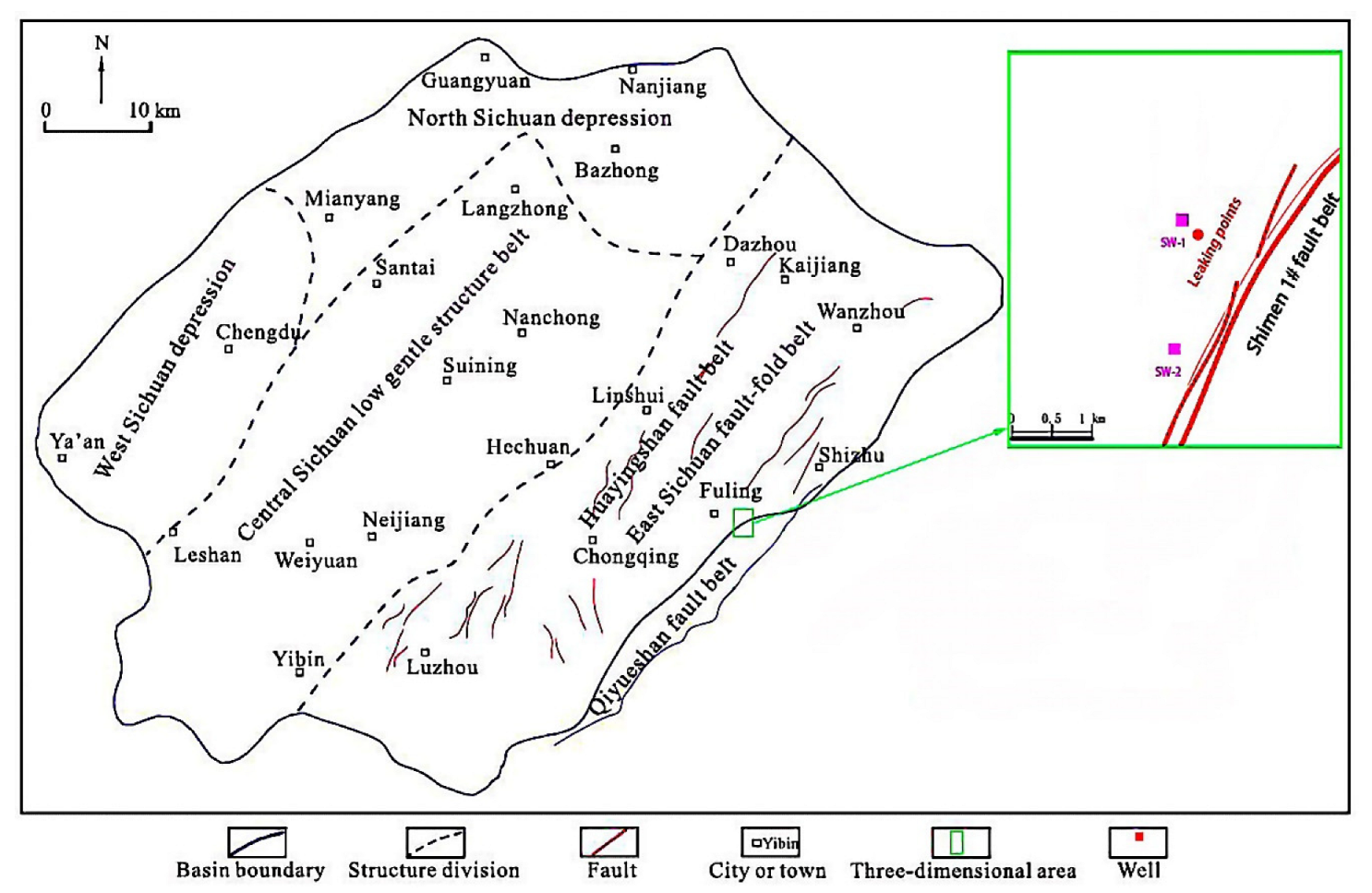
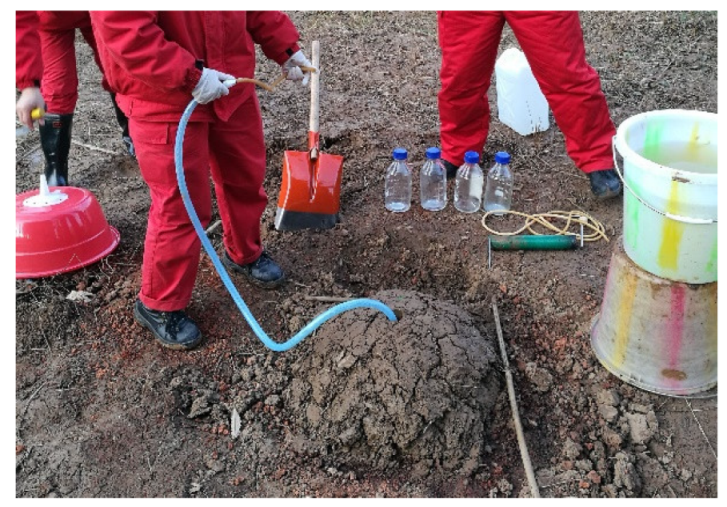
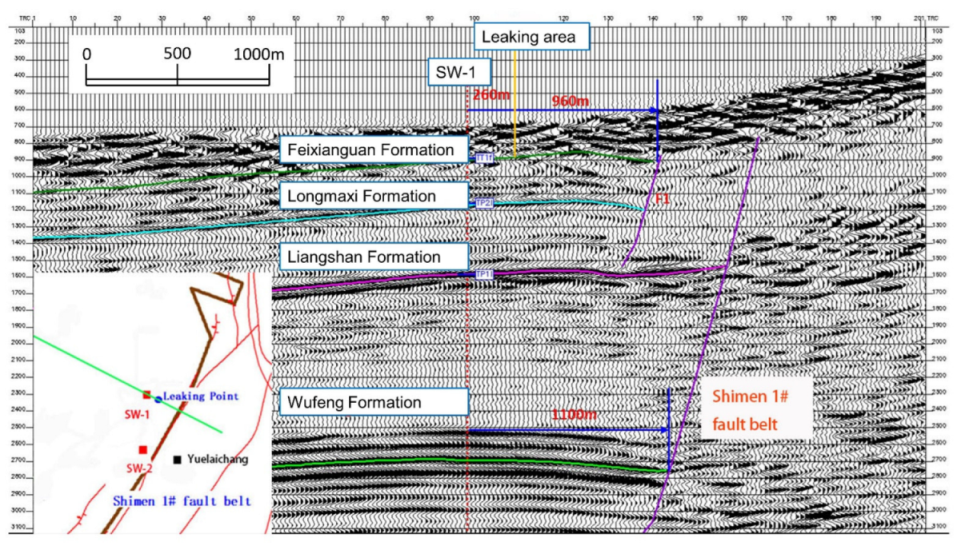
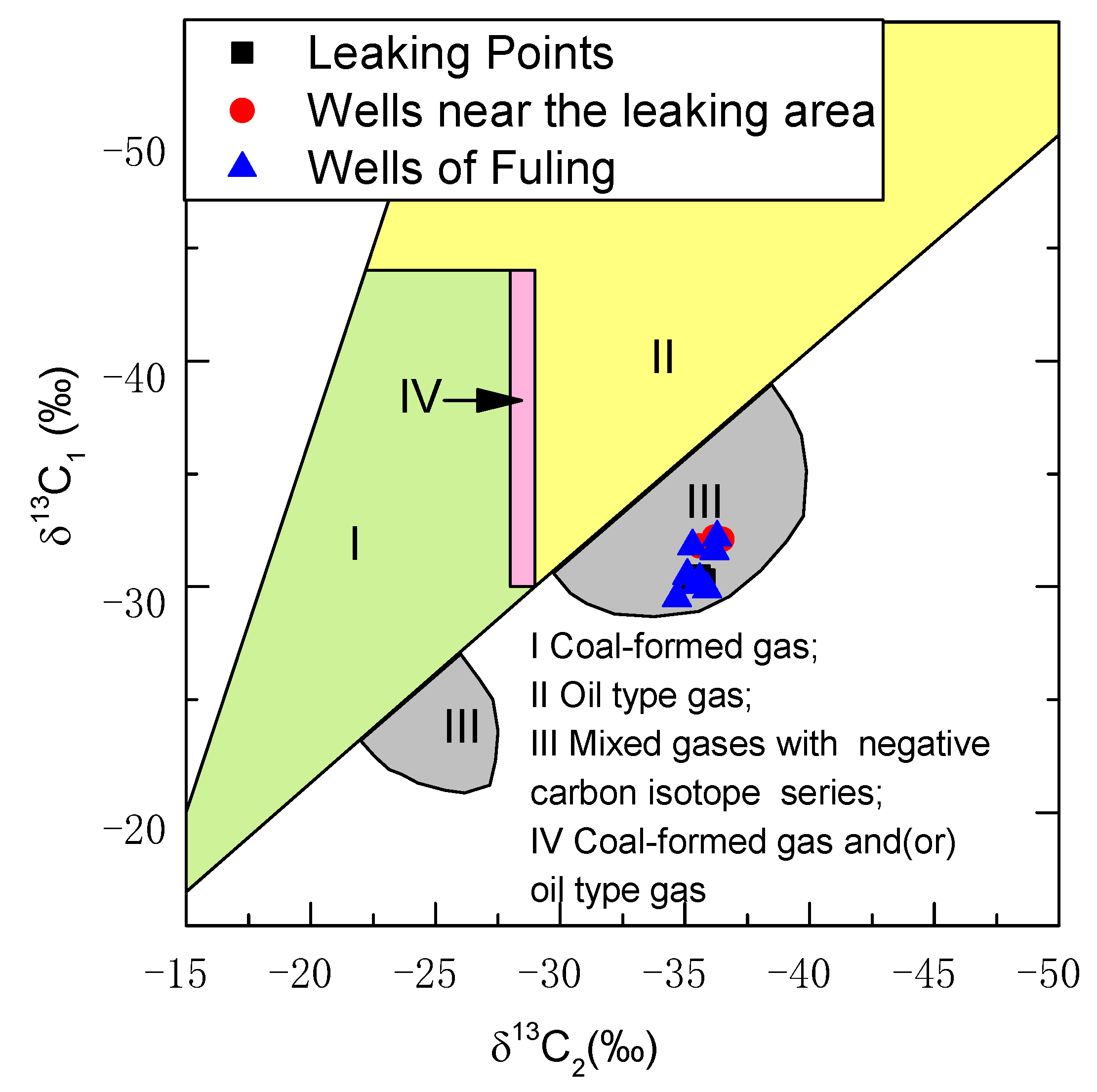

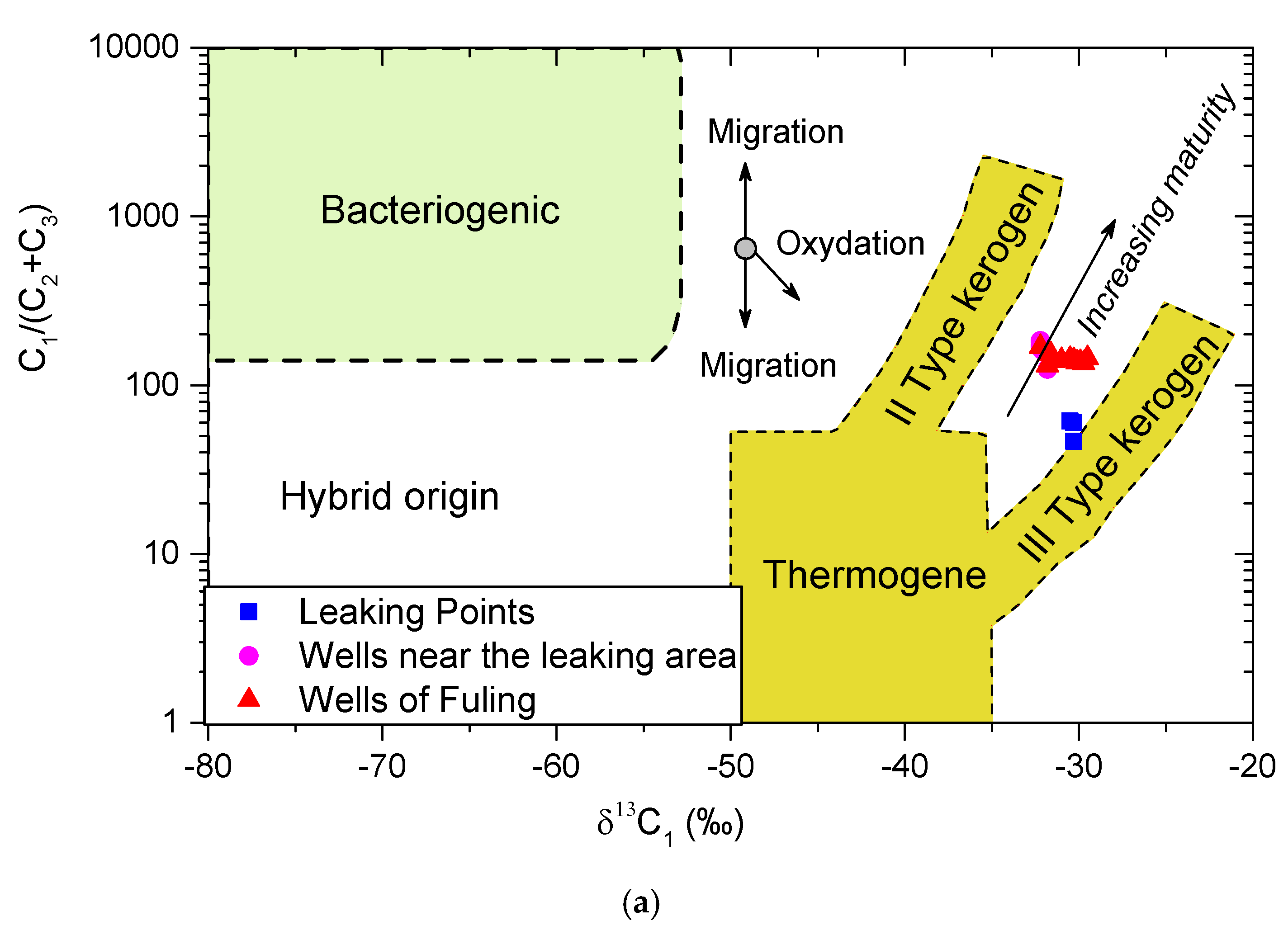
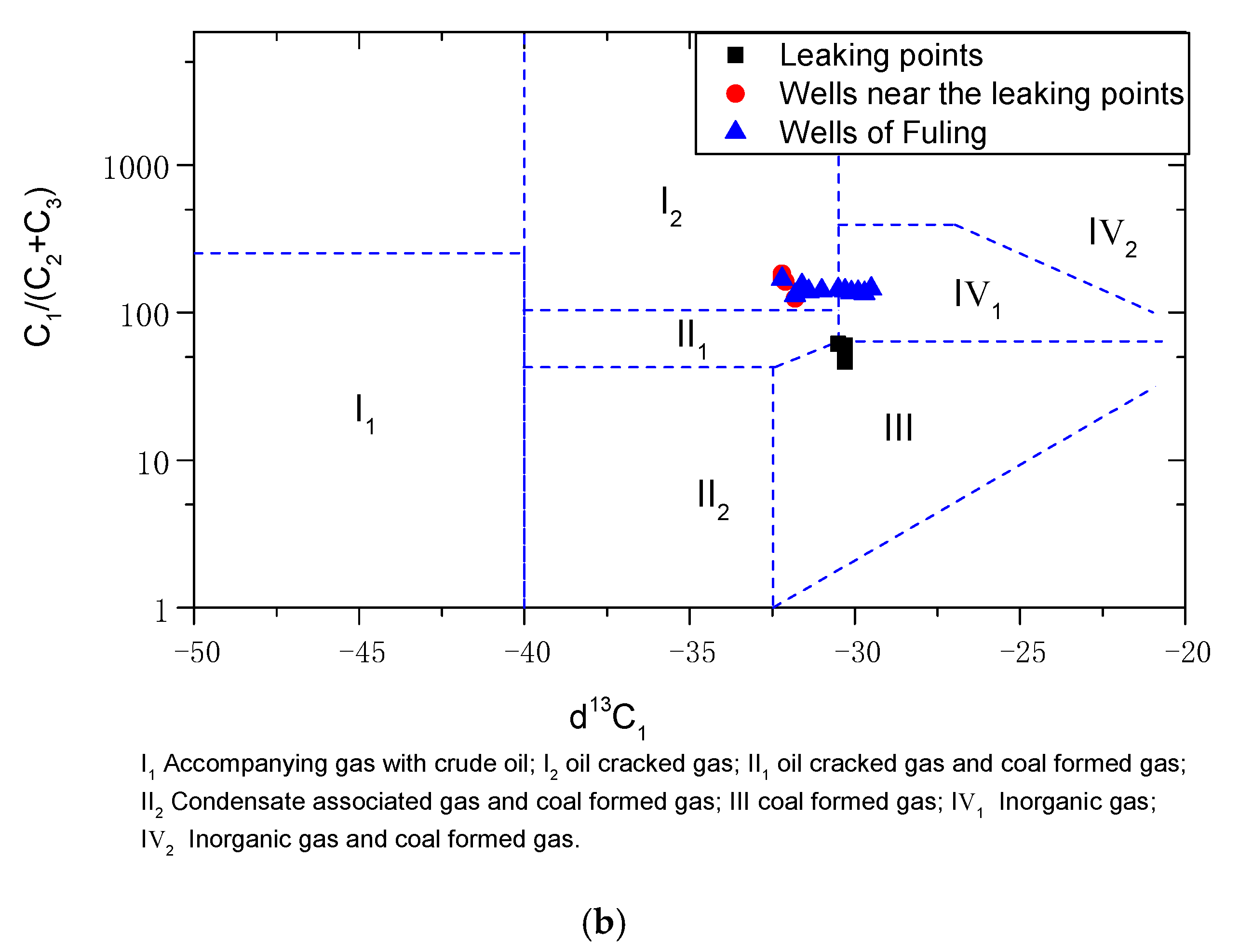
| Latitude (N) | Longitude (E) | Altitude (m) | |
|---|---|---|---|
| LKP-1 | 20°40′30.81″ | 107°36′3.04″ | 527 |
| LKP-2 | 29°40′31.08″ | 107°36′3.26″ | 528 |
| LKP-3 | 29°40′31.42″ | 107°36′3.00″ | 523 |
| LKP-4 | 29°40′31.01″ | 107°36′2.89″ | 523 |
| LKP-5 | 29°40′31.91″ | 107°36′2.32″ | 522 |
| LKP-6 | 29°40′32.12″ | 107°36′2.29″ | 521 |
| LKP-7 | 29°40′33.79″ | 107°36′2.59″ | 517 |
| LKP-8 | 29°40′34.24″ | 107°36′2.91″ | 513 |
| LKP-9 | 29°40′34.28″ | 107°36′2.38″ | 510 |
| LKP-10 | 29°40′34.41″ | 107°36′2.11″ | 510 |
| LKP-11 | 29°40′29.10″ | 107°36′8.42″ | 521 |
| LKP-12 | 29°40′21.51″ | 107°35′58.36″ | 521 |
| LKP-13 | 29°40′16.05″ | 107°35′57.36″ | 518 |
| Site | Gas Composition (vol.%) | C1/(C2+C3) | Stable Carbon Isotope, δ13C(‰) | Reference | |||||
|---|---|---|---|---|---|---|---|---|---|
| CH4 | C2H6 | C3H8 | CO2 | CH4 | C2H6 | CO2 | |||
| LKP-1 | 87.05 | 1.09 | 0.33 | 11.54 | 61.30 | −30.5 | −35.6 | −26.7 | This study |
| LKP-2 | 86.62 | 1.86 | 0 | 11.53 | 46.57 | −30.3 | −35.3 | −26.3 | |
| LKP-3 | 85.59 | 1.06 | 0.37 | 12.99 | 59.85 | −30.3 | −35.8 | −31.0 | |
| SW-1-1 | 98.32 | 0.75 | 0.04 | 0.20 | 124.46 | −31.8 | −35.6 | ||
| SW-1-2 | 98.87 | 0.52 | 0.02 | 183.09 | −32.2 | −36.2 | |||
| SW-2-1 | 98.64 | 0.58 | 0.03 | 161.70 | −32.1 | −36.5 | |||
| SW-2-2 | 98.74 | 0.56 | 0.02 | 170.24 | −32.2 | −36.2 | |||
| JY1 | 98.52 | 0.67 | 0.05 | 0.32 | 136.83 | −30.1 | −35.5 | Dai et al. [23] | |
| JY1-2 | 98.8 | 0.7 | 0.02 | 0.13 | 137.22 | −29.9 | −35.9 | ||
| JY1-3 | 98.67 | 0.72 | 0.03 | 0.17 | 131.56 | −31.8 | −35.3 | ||
| JY4-1 | 97.89 | 0.62 | 0.02 | 0.17 | 152.95 | −31.6 | −36.2 | ||
| JY4-2 | 98.06 | 0.57 | 0.01 | 169.07 | −32.2 | −36.3 | |||
| JY7-2 | 98.84 | 0.67 | 0.03 | 0.14 | 141.20 | −30.3 | −35.6 | ||
| JY12-3 | 98.87 | 0.67 | 0.02 | 143.29 | −30.5 | −35.1 | |||
| JY13-3 | 98.57 | 0.66 | 0.02 | 0.25 | 144.96 | −29.5 | −34.7 | ||
| JY20-2 | 98.38 | 0.71 | 0.02 | 134.77 | −29.7 | −35.9 | |||
| JY42-1 | 98.54 | 0.68 | 0.02 | 0.38 | 140.77 | −31.0 | −36.1 | ||
| JY42-2 | 98.89 | 0.69 | 0.02 | 139.28 | −31.4 | −35.8 | |||
| JY1-HF | 98.10 | 0.59 | 0.23 | 0.20 | 119.63 | −29.7 | −34.5 | Xin et al. [18] | |
| JY11-4-1 | 96.98 | 0.62 | 0.01 | 1.17 | 153.94 | −31.47 | −31.74 | −17.63 | |
| JY11-4-2 | 96.12 | 0.81 | 1.67 | 118.67 | −32.77 | −35.01 | −18.84 | ||
| JY11-4-8 | 95.89 | 0.76 | 0.01 | 0.08 | 124.53 | −31.30 | −38.03 | −15.66 | |
| JY11-4-9 | 94.02 | 0.99 | 0.01 | 0.17 | 94.02 | −32.18 | −38.21 | −19.80 | |
| JY11-4-10 | 93.14 | 0.85 | 0.41 | 109.58 | −30.95 | −37.13 | −20.08 | ||
| JY11-4-11 | 92.88 | 0.82 | 0.01 | 0.23 | 111.90 | −23.28 | −36.96 | −22.54 | |
| JY1 | 98.52 | 0.67 | 0.05 | 0.32 | 136.83 | −29.9 | −35.9 | 5.9 | Wu et al. [17] |
| JY11-2 | 98.63 | 0.69 | 0.02 | 0.23 | 138.92 | −30.4 | −35.9 | 8.0 | |
| JY1-3 | 98.67 | 0.72 | 0.03 | 0.17 | 131.56 | −31.8 | −35.3 | 6.1 | Wu et al. [24] |
Publisher’s Note: MDPI stays neutral with regard to jurisdictional claims in published maps and institutional affiliations. |
© 2022 by the authors. Licensee MDPI, Basel, Switzerland. This article is an open access article distributed under the terms and conditions of the Creative Commons Attribution (CC BY) license (https://creativecommons.org/licenses/by/4.0/).
Share and Cite
Zhang, Y.; Mao, H.; Zhang, Z.; Jiang, S.; Liu, Y. A Shale Gas Leaking Incident in Fuling Shale Gas Field in Chongqing, China: A Case Study. Energies 2022, 15, 5261. https://doi.org/10.3390/en15145261
Zhang Y, Mao H, Zhang Z, Jiang S, Liu Y. A Shale Gas Leaking Incident in Fuling Shale Gas Field in Chongqing, China: A Case Study. Energies. 2022; 15(14):5261. https://doi.org/10.3390/en15145261
Chicago/Turabian StyleZhang, Ye, Haijun Mao, Zhiping Zhang, Shu Jiang, and Yiming Liu. 2022. "A Shale Gas Leaking Incident in Fuling Shale Gas Field in Chongqing, China: A Case Study" Energies 15, no. 14: 5261. https://doi.org/10.3390/en15145261






